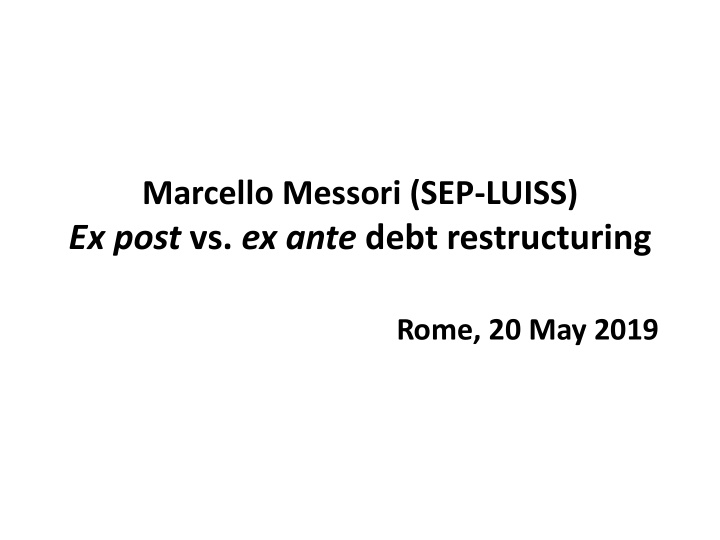



Marcello Messori (SEP-LUISS) Ex post vs. ex ante debt restructuring Rome, 20 May 2019
Overview • The aim of my intervention is to show that the EMU’s most fragile countries (such as Italy) → an unfavorable bargain between two new roles of the ESM: - backstop in the 2nd pillar of the BU (by 2020 ), as stated by the Eurogroup (December 4 th , 2018); - possibly, decision-maker of an ex ante public debt restructuring (SDRM).
Outline • Three steps to pursue this aim: (1) Short recall of the recent evolution in EU + EMU economic governance; (2) Possible results of European meetings (end 2018) Eurogroup (December 4 th , 2018) and European Council; (3) How Italy is hit by these results → active role to play.
1. Evolution of European governance • From 5 Presidents’ Report (mid -2015) to the election of Macron (mid-2017) = stalemate in EU and EMU’s economic governance. • Second half of 2017 = EC particularly active ➔ Completing the banking union (October) Deepening Europe’s Economic and Monetary Union (December).
1. Evolution of European governance • EC + Euro-summit (end 2017): - completion of BU (backstop + EDIS) and progress in CMU; - stabilization and counter-cyclical tools to manage asymmetric shocks and to improve convergence; - creation of a euro-area budget; - transformation of ESM into EMF; - creation of a European Minister of Economy .
1. Evolution of European governance • 2018 Euro-summit and Eurogroup meetings ( March and June) attested a new stalemate in European economic governance. • Evidence: Centeno’s letter to Tusk (June) → (i) new roadmap for the BU; (ii) indicating possible tools for convergence; (iii) fixing some aspects for the ESM’s reform. • (i) and (ii)-(iii) bring back the debate to: fall 2012 and mid-2017, respectively.
1. Evolution of European governance • Eurogroup’s last meeting (December 2018): (a) ESM as a backstop (revolving credit line by 2020), subject to further risk reduction and with serious problems of implementation; (b) no common view on ESM’s instruments for fiscal stabilization and convergence (see Term sheet on ESM reform ); (c) no actual progress on euro-area budget; (d) significant progress on ESM as decision- maker of an ex ante public debt restructuring.
2. Achievements of impending meetings • (b) – (c) contrasting view between EMU’s member states (mainly: Northern countries, Germany, and France) → open problem: - ESM can offer assistance without triggering a full aid program? • ESM functions ➔ beyond crisis management: (i) mediation between creditors and member- states (even if voluntary and non-binding); (ii) single-limb CACs for new issuances to prevent holdouts (by 2022).
2. Achievements of impending meetings • Single-limb CACs = approval of a restructuring qualified majority for the whole set of bondholders. Hence, the approval of a restructuring process on the whole stock of national public debt is easier. • (i) and (ii) = first steps to endow ESM with the power of settling ex ante a (quasi-automatic) public debt restructuring (SDRM).
2. Achievements of impending meetings • Hence, European Council + Euro-summit ( December’s meetings): - Launch of an inadequate backstop for the 2 nd pillar of the BU (by 2020); - Approval of single-limb CACs (by 2022) + ESM’s mediation role ➔ a ‘Trojan horse’ to ease the implementation of ex ante quasi-automatic debt restructuring.
2. Achievements of impending meetings • EC = has the power to check the sustainability of MS’s balance sheets; EC + ESM = already have the power to state that a country under a European aid program has an unsustainable public debt ( Agreement , November 14 th , 2018). • This ➔ ex post debt restructuring = unavoidable and efficient. Single-limb CACs are necessary to limit the veto- power of an organized minority of investors.
3. Italy’s recommended position • ESM’s new possible power to state the ex ante quasi-automatic debt restructuring ➔ a dramatic change. • The ex ante debt restructuring ➔ perverse incentive schemes, triggering macroeconomic instability. Hence: in this case, no single-limb CaCs.
3. Italy’s recommended position • Italy would have to remain compliant with European rules and save its reputation for several reasons. • One of these reasons is, being the EMU’s most important ‘fragile’ country, Italy would have to credibly state that: (a) ESM as a backstop = immediately operative without further risk reduction: a ‘vested’ component of the BU.
3. Italy’s recommended position (b) Restructuring of public debts would have to be carried out only ex post upon: - assessment of debt unsustainability by EC and ESM; - request of the country in difficulty.
3. Italy’s recommended position (c) No form of ex ante quasi-automatism. (d) Possible related application of any collective action clause would require that restructuring is not ex ante but only ex post .
Recommend
More recommend